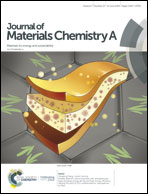Stable high current density operation of La0.6Sr0.4Co0.2Fe0.8O3−δ oxygen electrodes†
Abstract
Solid oxide cells operated reversibly between fuel cell and electrolysis modes are promising for energy storage with extremely high capacity. La0.6Sr0.4Co0.2Fe0.8O3−δ (LSCF) has become the dominant oxygen electrode material in electrolysis and reversible operation. However, LSCF has been widely reported to degrade due to Sr surface segregation. The present understanding is that the segregation rate and hence the degradation rate increases with increasing temperature and current density. Here we present a study of LSCF electrode performance and stability carried out with a series of extended life tests (1000 hours) over a range of temperatures and reversing current densities. Although the results at lower temperatures (650–700 °C) show the expected increase in segregation-induced degradation with increasing current density, at higher temperature (750 °C) stability is improved and the electrodes become fully stable at the highest current density of 1.5 A cm−2, maintaining a stable polarization resistance of 0.08 Ω cm2. This unexpected result is explained by the increased electrochemical activity of LSCF at the higher temperature and a very rapid development of a stable surface segregated Sr layer.



 Please wait while we load your content...
Please wait while we load your content...